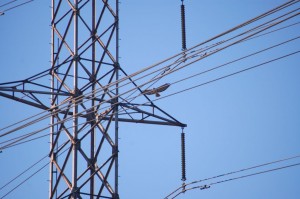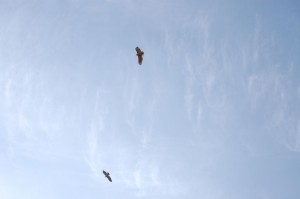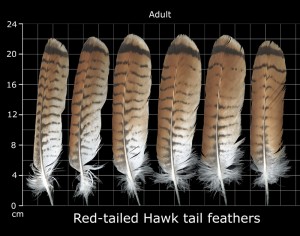 I love a rainy night. A rainy day, too. But I'll never forget the mountains of trash that wash into Southland waterways after storms. It's particularly depressing to see trash strewn in the branches of trees and shrubs, as you can see behind the ducks in this picture of the Glendale Narrows stretch of the LA River.
I love a rainy night. A rainy day, too. But I'll never forget the mountains of trash that wash into Southland waterways after storms. It's particularly depressing to see trash strewn in the branches of trees and shrubs, as you can see behind the ducks in this picture of the Glendale Narrows stretch of the LA River. I took the photo above (and the one below) a couple weeks ago along the Rio Hondo, a tributary of the LA River. In addition to the ubiquitous shopping carts, plastic bags, styrofoam cups, soda cans, etc, there was a surprising number of rubber balls.
I took the photo above (and the one below) a couple weeks ago along the Rio Hondo, a tributary of the LA River. In addition to the ubiquitous shopping carts, plastic bags, styrofoam cups, soda cans, etc, there was a surprising number of rubber balls.
(sound up on: splashing, scraping, women chatting
“we need another bag”)
SETZIOL: After a fall rainstorm, nine women inmates haul trash out of a channel that flows into Newport Bay. Gloria Sauer with Orange County public works oversees the crew.
SAUER: Girls, get all of the floatable stuff. All of the trash and debris you see, the styrofoam cups and the glass, okay.
SETZIOL: The trash is caught behind a net that public works has installed to try to keep it from flowing into the bay and out to the ocean. In about an hour, the crew hauls out a couple hundred pounds plastic cups, water bottles, broken furniture and other trash. Orange County is still trying to get a handle on the total amount of trash is blowing or washing in county waterways—and where exactly it’s all coming from. Vince Gin is with the OC watershed division.
GIN: It could be a trash bag blown of a trash truck, or it could be a cup that didn’t make its way to a trash can. Sometimes, unfortunately it could be litter that someone has thrown out of a car and onto a street.
SETZIOL: Despite local efforts to capture trash, some of it ends up in the ocean. Of most concern is the plastic, because it’s so durable.
(sound of bubbling water)
In a lab in Redondo Beach, Charles Moore with the Algalita Marine Research Foundation is examining what’s in the stomach of an Albatross from the Hawaiian islands.
MOORE: Here we have a lid of some kind of bottle cap to a pen…different types of caps…Here’s a piece of jewelry.
SETZIOL: And lots of pieces of red, yellow and blue plastic. Big ones.
MOORE: Look at this we’ve got a toy bear
SETZIOL: An entire miniature, plastic toy bear.
SETZIOL: Moore says the birds didn’t evolve with plastic, so they have no way to distinguish it from food.
MOORE: They’re filling up on maybe a large percentage of non-digestible,non-nutritive plastic and feeding it to their chicks. So the chicks have what’s called a satiation reflex—it’s getting fuller and fuller and finally it stops demanding food from the parents.
SETZIOL: Moore says about 70 species of sea birds have been found to eat plastic. Researchers have also documented sea turtles and whales killed or injured by ingesting plastic bags and mylar balloons.
The Algalita Foundation thinks southern California is a major source. It sampled ocean waters at the mouths of the LA and San Gabriel Rivers and found 2 and a half grams of plastic for every gram of plankton at the surface--much of it very small pieces.
ANDRADY: Smaller particles I contend would be far more damaging from an ecological perspective.
Dr. Anthony Andrady is a polymer scientist with the research company RTI International. He says UV light gradually breaks plastic into smaller and smaller pieces. His research has found that krill and other zooplankton will eat significant amounts of microscopic plastic.
ANDRADY: That is particularly disconcerting because the food pyramid rests on zooplankton health. But whether that has an effect on them we don’t know.
SETZIOL: Researchers in Japan have found that pieces of plastic placed in seawater will absorb PCBs and other toxins. But scientists don’t know if marine life that eats plastic would absorb any of the pollution.
ANDRADY: It’s an unanswered question and when you have an unanswered question of this magnitude, it’s worrisome and we need to find an answer to this.
SETZIOL: Plastic doesn’t just breaking down in the ocean. It fragments on land and in rivers. The Algalita Foundation points out that the nets public works departments use capture trash don’t snag the small stuff.
(Clean up sounds up)
GIN: We can only pick up so much.
Vince Gin of the Orange County Watershed Department.
GIN: Trying to fight the problem by combating it after it’s already in the system is a losing battle. We have to work on reducing how much trash we create; prevention is absolutely key.
(trash hauling sounds)
In Newport Beach, Ilsa Setziol, 89.3, KPCC








































